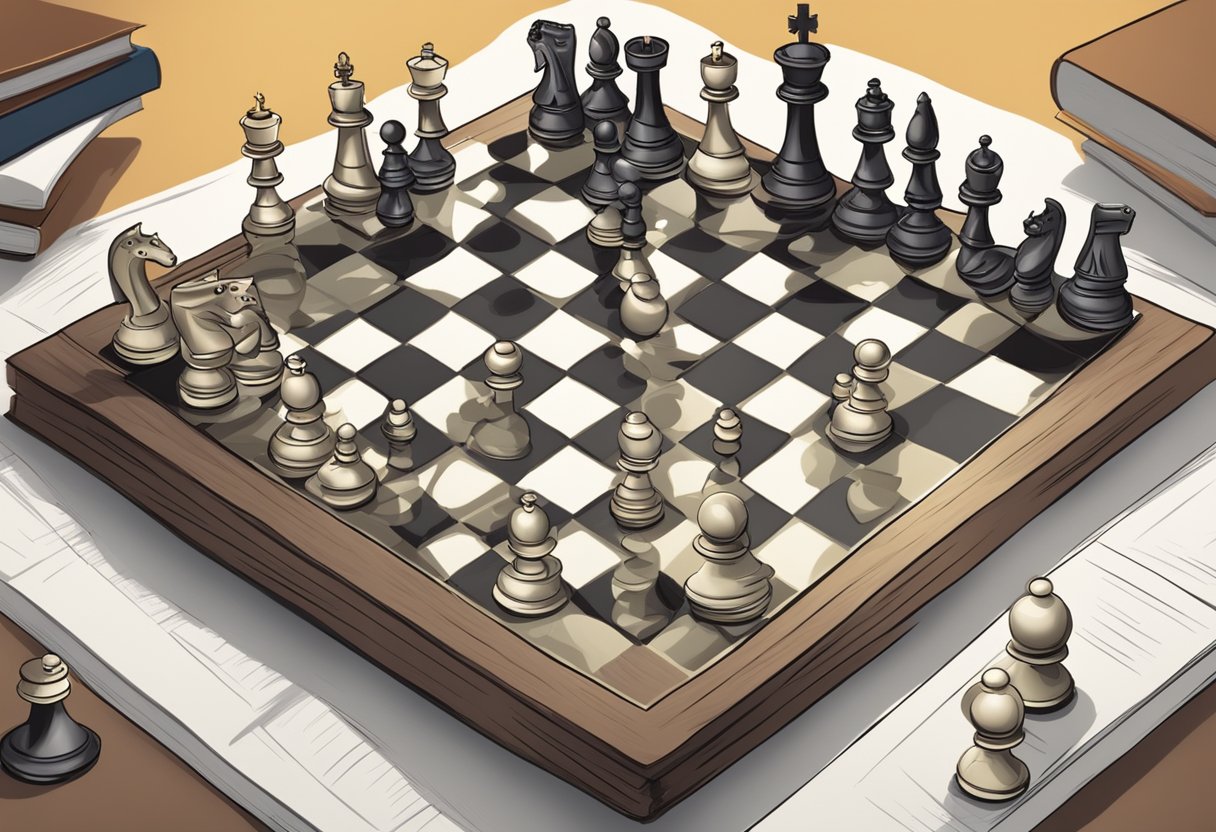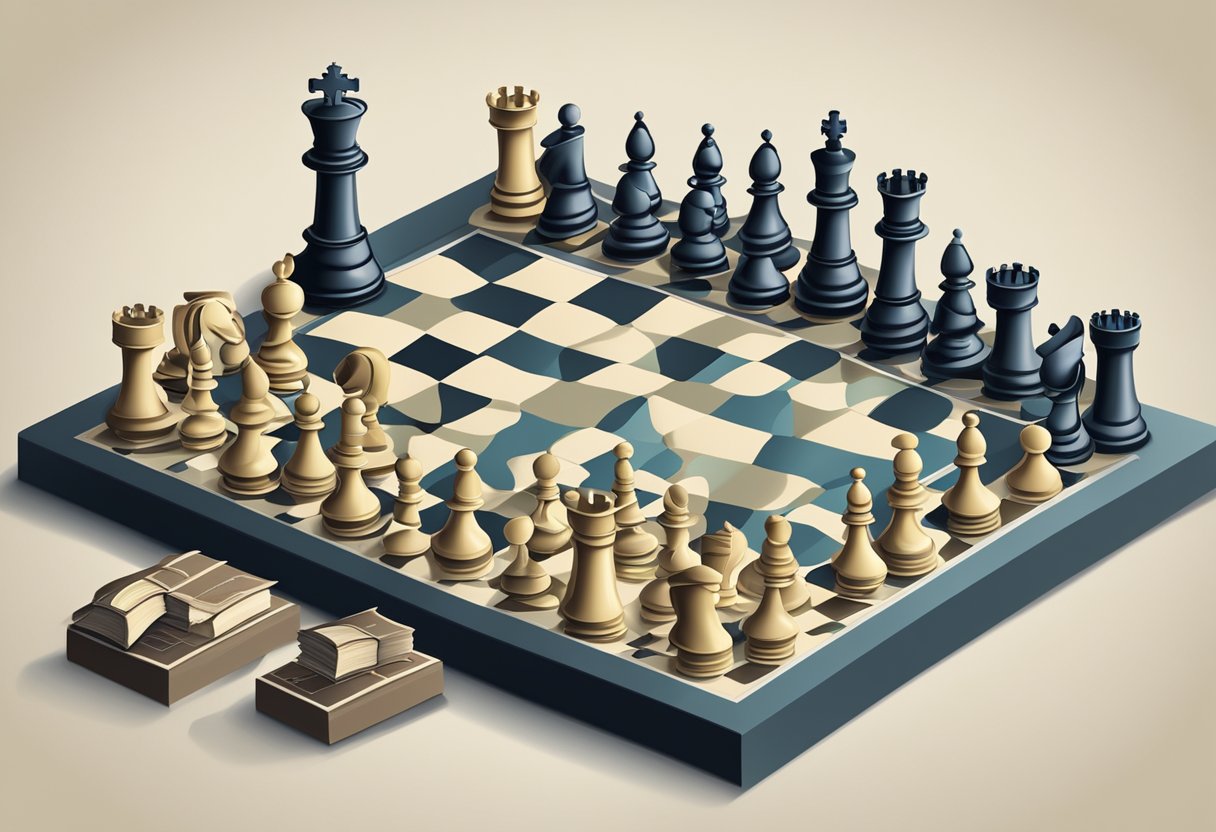Strategic thinking is the ability to analyze, visualize, and plan for the future to achieve a set of goals or objectives. It involves seeing the big picture and anticipating threats, vulnerabilities, and opportunities to pursue, with the ultimate aim of attaining a competitive edge in a constantly changing environment. Strategic thinking is often seen as a crucial skill in organizational leadership, enabling individuals to make informed decisions and adapt to shifting circumstances.

One key aspect of strategic thought is the ability to envision and adapt to potential scenarios – be they opportunities or challenges – while keeping the long-term goals in mind. This involves evaluating information from various angles and considering the impact of each approach. By doing so, strategic thinkers can help organizations navigate complex situations, generate innovative solutions, and cultivate a culture of adaptability and resilience.
Key Takeaways
- Strategic thinking involves analyzing and planning for the future to achieve set goals, while addressing potential threats and opportunities.
- Envisioning and adapting to various scenarios while maintaining long-term objectives is key to effective strategic thought.
- Organizations benefit from strategic thinkers by improving their adaptability, resilience and ability to innovate in a competitive environment.
Defining Strategic Thought

Strategic thought is the mental process of analyzing situations, identifying patterns, and anticipating potential outcomes with a long-term perspective. It surpasses day-to-day problem-solving and focuses on a broader vision, taking into account the immediate and future implications of actions and decisions1. Essentially, strategic thinking is a form of critical thinking that involves evaluating possible scenarios to achieve a specific goal or set of goals2.
There are several key characteristics of somebody skilled in strategic thought:
- Analytical ability: This involves evaluating critical factors and variables that can have an impact on long-term success3.
- Pattern recognition: Strategic thinkers have a gift for discerning patterns, contributing to more informed decision-making4.
- Connecting the dots: Strategists can make sense of overarching trends, allowing them to better plan for the future5.
- Contextualizing information: Individuals adept at strategic thinking can understand information from the past, present, and future, guiding both short-term and long-term goals5.
Moreover, strategic thought is not limited to business or leadership roles; it can be applied to various fields and disciplines, such as sports, military, and politics. Strategic thinking is a valuable skill that can significantly improve decision-making and long-term success for individuals, teams, and organizations2.
In summary, strategic thought is a systematic and intentional process that plays a crucial role in the pursuit of long-term goals by analyzing scenarios, recognizing patterns, and foreseeing potential consequences.
Footnotes
Importance of Strategic Thought

Strategic thought is a vital aspect of ensuring long-term success for individuals, teams, and organizations. It is an intentional and rational thought process, focused on analyzing critical factors and variables that influence the achievement of goals and objectives. When employed effectively, strategic thought leads to better decision-making, improved problem-solving, and increased innovation.
The success of any organization or individual is highly dependent on their ability to think strategically. This thought process allows them to have a clear vision of their goals and ensures that they remain focused on what is truly important. By taking a step back to assess the bigger picture and considering long-term effects of their decisions, they can better allocate resources and plan for the future.
Effectiveness in problem-solving stems from a strategic mindset. Through this type of thinking, individuals and teams can evaluate alternatives and adapt decision-making to align with their ultimate goals. This fosters a proactive approach to tackling challenges and mitigating risks before they escalate, resulting in more efficient and successful outcomes.
Moreover, strategic thought drives innovation within organizations. It encourages individuals to connect the dots between seemingly unrelated concepts and develop creative solutions. This process of critical thinking, foresight, and setting strategic direction contributes to a culture of continuous improvement and innovation.
- Critical thinking: Assessing the assumptions, conclusions, and implications of a decision
- Foresight: Anticipating future needs, obstacles, and opportunities
- Setting strategic direction: Establishing a path towards long-term objectives
In essence, strategic thought allows organizations and individuals to remain agile and adaptable in an ever-changing landscape. By fostering a strategic mindset and prioritizing long-term success over short-term gains, leaders and team members can make more informed decisions, embrace innovation, and ultimately, achieve their desired objectives.
Elements of Strategic Thought

Strategic Thinking Skills
Strategic thinking is an essential skill for professionals in different sectors since it deals with the ability to analyze, innovate and foresee future scenarios. It involves focusing on long-term goals while considering possible external factors that may impact the achievement of those goals. Key elements of strategic thinking include analytical thinking, critical thinking, and foresight.
- Analytical thinking refers to the ability to break down complex problems into smaller components and understand their implications.
- Critical thinking involves questioning common assumptions, beliefs, and practices, asking tough questions to evaluate and challenge conventional wisdom.
- Foresight is the ability to anticipate potential problems, identify opportunities and trends, and prepare for various scenarios.
By incorporating these essential thinking skills, professionals can effectively develop a comprehensive understanding of their goals, formulate strategic plans, and improve their problem-solving abilities.
Strategic Planning
Strategic planning is the next step in the process, which devises the action plan required to achieve the organization’s long-term objectives. It is crucial for setting strategic direction and aligning the organization’s resources and efforts towards these goals. Important aspects of strategic planning include perspective, innovation, and tactics.
Perspective is essential for understanding the broader context in which an organization operates and for identifying its competitive advantages and disadvantages. It allows decision-makers to develop a holistic view of the organization’s current situation and future possibilities.
Innovation is crucial for creating a sustainable competitive advantage. By continuously seeking new ideas and opportunities, organizations can adapt and grow in rapidly changing environments.
Tactics refer to the specific actions and decisions that need to be made and executed to achieve the strategic objectives. Tactical plans should be developed for different timeframes and scenarios to ensure a flexible and adjustable approach.
In summary, strategic thinking and strategic planning are crucial components of setting an organization on the path to long-term success. By incorporating analytical thinking, problem-solving skills, and innovation into their approach, professionals can better prepare for and overcome future challenges, ultimately ensuring the achievement of their strategic goals.
The Role of Leadership in Strategic Thought
Leaders and Strategic Thought
Strategic thought is an essential aspect of effective leadership. Leaders must possess a clear vision that guides their decision-making and inspires their teams. They must continually scan the environment for new ways to contribute to the organization’s success and adapt their strategies accordingly. By incorporating strategic thinking into their leadership style, they can develop creative problem-solving skills and lead their teams towards long-term goals.
One important element of strategic thought for leaders is effective communication. This involves not only conveying their vision to their teams, but also fostering open dialogues that encourage collaboration and knowledge-sharing. Leaders must be proactive listeners, taking in valuable feedback from all levels of the organization to refine their strategies and drive success.
Strategic Thought in Leadership Development
Incorporating strategic thought into leadership development programs is vital for nurturing future leaders. Harvard Business Publishing suggests that strategic thinking skills are crucial for employees at all levels to contribute to the success of the organization.
As the future leaders move through their career, they benefit from the strategic thought provided by executive coaching and other development opportunities. These programs can focus on cultivating strategic thinking skills such as:
- Vision: Developing a clear direction for the organization and the ability to communicate it effectively.
- Decision-making: Applying critical thinking and analysis to make informed choices for the organization’s future.
- Communication: Building strong relationships and fostering open dialogues about the organization’s goals.
By developing these competencies, future leaders can demonstrate their strategic thought capabilities to senior leaders and position themselves for career advancement and promotion. In summary, strategic thought plays a crucial role in effective leadership and leadership development, with a focus on elements such as vision, decision-making, and communication.
Incorporating Strategic Thought in HR
Integrating strategic thought into Human Resources (HR) plays a crucial role in organizations and greatly benefits both the company and its employees. In order to effectively incorporate strategic thinking, HR professionals must focus on long-term goals and develop comprehensive plans to achieve them1.
One common approach to implement strategic thought in HR is by analyzing the overall needs of the organization. This includes an assessment of current and future workforce requirements, skill gaps, and employee development needs. It is essential for HR professionals to be aware of industry trends and external factors that may impact the company in the long run2.
By aligning HR strategies with organizational goals, it becomes possible to develop and promote a strong company culture. This includes effective communication channels, a well-defined values system, and employee recognition programs3. Creating an environment where employees feel supported and valued contributes to improved morale, increased productivity, and better overall organizational performance.
In addition to company culture, successful integration of strategic thought in HR involves three main components:
- Talent Acquisition: Recruiting and retaining top talent is crucial for any organization. HR professionals should always be on the lookout for skilled employees, focusing on both current and anticipated needs3. Implementing strategies to identify, attract, and hire candidates in line with the company’s goals ensures a steady stream of talent.
- Employee Development: Investing in the professional growth of employees benefits both the individuals and the organization. Offering training programs, coaching2, and promotion opportunities enables employees to acquire new skills and advance their careers. This results in higher job satisfaction and lower turnover rates.
- Performance Management: Regularly evaluating employee performance is key to promoting a results-oriented culture4. Establishing a clear performance review process along with setting SMART goals ensures that every team member is aware of their responsibilities, contributions, and areas for improvement.
Ultimately, incorporating strategic thought in HR requires a shift in mindset from solely focusing on day-to-day tasks to prioritizing long-term planning and organizational growth. By implementing strategic thinking, HR has the potential to positively impact employee satisfaction, as well as overall company success5.
Footnotes
- https://eddy.com/shift-to-strategic-hr/ ↩
- https://hrmhandbook.com/core/strategic-thinking/ ↩ ↩2
- https://www.betterworks.com/magazine/hr-strategy/ ↩ ↩2
- https://www.shrm.org/hr-today/news/hr-news/Pages/thinkstrategically.aspx ↩
- https://hbr.org/2019/09/how-to-demonstrate-your-strategic-thinking-skills ↩
Strategic Thought and Innovation
Strategic thought is the ability to analyze situations, identify patterns, and anticipate potential outcomes with a long-term perspective. It goes beyond day-to-day problem-solving and takes into account the immediate and future implications of actions and decisions. In the context of innovation, strategic thinking plays a crucial role in driving organizational growth and creating competitive advantage.
Innovation is the process of developing and implementing new ideas, products, services, or processes that drive significant organizational growth, competitive advantage, and long-term success. It involves aligning these innovative efforts with the overall strategic goals and vision of an organization. In this regard, strategic thinking serves as a cornerstone for fostering an environment that encourages and sustains innovation.
One aspect of strategic thought is the ability to recognize opportunities for innovation. This might include:
- Identifying current or emerging market trends
- Recognizing untapped customer needs
- Analysing competitor activities to spot gaps in the market
Strategic thinkers who focus on innovation typically possess an inquisitive mind, often questioning and challenging conventional thinking. They have the ability to think ahead, anticipate potential problems, and develop backup plans that help them pivot quickly when things don’t go as planned.
There are several ways that strategic thought can facilitate the innovation process, such as:
- Encouraging collaboration and communication among team members, promoting the exchange of diverse ideas and perspectives.
- Utilizing research and analytics to gather data, identify emerging trends, and refine innovative concepts.
- Developing a solid structure and process for managing and executing innovative ideas, ensuring that resources are allocated efficiently and objectives are achieved.
In conclusion, strategic thought is an essential component of innovation, driving the development and implementation of new ideas that can propel an organization forward. It is the foundation for guiding and managing the innovation process, ensuring that innovative solutions align with an organization’s long-term growth and success.
Challenges in Strategic Thought
Strategic thought is a valuable skill that helps individuals and organizations analyze situations, identify patterns, and anticipate potential outcomes with a long-term perspective. However, there are several challenges that can hinder effective strategic thinking, including assumptions, obstacles, and conflict.
One common challenge in strategic thinking is making assumptions. It is natural for individuals to base judgments and decisions on their own experiences and biases. This can sometimes lead to incorrect or incomplete understanding of a situation, affecting the ability to think strategically. To overcome this issue, it is important to question and challenge personal assumptions and seek input from diverse perspectives.
Another obstacle in strategic thinking is the presence of internal and external barriers. Internal barriers may include lack of resources, skills, or support from stakeholders, while external barriers may encompass market competition, regulatory constraints, or changing customer preferences. Strategic thinkers must identify and understand these obstacles to determine how they may affect the overall goals and objectives of the organization. They can then develop innovative solutions to overcome or minimize the impact of these barriers.
Conflict is another challenge that strategic thinkers often face. Disagreements among team members or stakeholders can slow down the decision-making process and impede the execution of strategic plans. To address such conflicts, strategic thinkers should employ clear communication, collaboration, and negotiation skills. Fostering a culture of trust and openness will help promote effective discussions and enable the resolution of conflicts in a timely manner.
In summary, strategic thinking is crucial for navigating complex situations and achieving long-term success. Recognizing the challenges of assumptions, obstacles, and conflict is an important step in enhancing one’s strategic thought process. By addressing these challenges, individuals and organizations will be better equipped to think strategically, make informed decisions, and achieve desired outcomes.
Strategic Thought in Decision Making
Strategic thinking is a crucial aspect of decision making, offering a more comprehensive and well-informed perspective. It goes beyond simply responding to immediate issues and encompasses a broader vision that considers both present and future implications. In essence, strategic thinking involves analyzing situations, identifying patterns, and anticipating potential outcomes with a long-term perspective in mind.
One of the key components of strategic thought in decision making is problem-solving. A strategic thinker analyses a problem from multiple angles, allowing them to identify the root causes, evaluate potential solutions, and select the most effective approach. This ensures a more robust resolution, which directly contributes to better decision-making and more successful outcomes.
In addition to problem-solving, strategic thinking also requires initiative and control. When faced with a challenge, a strategic thinker actively takes charge and explores various options. They don’t solely rely on others or pre-existing solutions but use their own knowledge and creativity to devise unique approaches. This proactive stance in decision making reflects the essence of strategic thought, which is about looking ahead and adapting to ever-changing situations.
A practical way to enhance strategic thought in decision making is by employing various cognitive tools and techniques. Some of these include:
- Scenario planning: Imagining various future scenarios and assessing the possible consequences of different decisions.
- SWOT analysis: Evaluating the Strengths, Weaknesses, Opportunities, and Threats related to a particular decision or situation.
- Balancing short-term and long-term perspectives: Weighing the immediate needs against future goals to ensure decisions account for both factors.
Incorporating strategic thought into decision making enables individuals and organizations to make informed choices that take into account the complexities of their environment. By implementing a strategic mindset and utilizing various analytical tools, it is possible to enhance decision-making skills, leading to greater success and long-term stability.
The Role of Technology in Strategic Thought
Technology plays a significant role in shaping and influencing strategic thought in organizations. It enables data-driven decision making, enhances efficiency, and unlocks new opportunities. In this section, we will discuss some of the ways technology intersects with strategic thinking.
One of the primary impacts of technology on strategic thought is the ability to access and analyze vast amounts of data quickly. The emergence of big data and analytics has empowered organizations to make informed decisions based on data-driven insights. Leaders can leverage this information to identify patterns, trends, and potential challenges, allowing them to craft strategies that are both adaptative and proactive.
In addition to data analysis, technology has also led to increased efficiency and optimization in various processes. The adoption of automation and artificial intelligence in businesses has streamlined operations, cutting down labor-intensive tasks and reducing human error. This enables organizations to allocate resources more effectively, setting the stage for strategic thinking that maximizes productivity.
Here is a list of key technology areas that support strategic thought:
- Data Analysis: Analyzing data to identify patterns, trends, and potential challenges.
- Automation: Streamlining operations through the use of automated systems and artificial intelligence.
- Collaboration Tools: Enhancing communication and collaboration among team members, fostering a culture of iterative thinking and continuous improvement.
- Predictive Analytics: Utilizing advanced algorithms and machine learning models to make accurate predictions, informing strategy development.
Another essential aspect of technology in strategic thinking is the capacity to innovate. Disruptive technologies, such as blockchain, the Internet of Things (IoT), and 3D printing, can create new markets and transform existing ones. By staying abreast of these developments, organizations can adapt and evolve their strategies to ensure a competitive edge.
In summary, technology’s role in strategic thought is multifaceted, acting as both a catalyst and enabler for informed, efficient, and innovative decision-making. Organizations that effectively harness technology’s potential can enhance their strategic thinking practices and achieve long-term success.
Strategic Thought in Organizational Performance
Resource Management and Strategic Thought
Effective strategic thinking plays a crucial role in the management of an organization’s resources. This process involves the intentional and rational analysis of critical factors that shape the long-term success of the business or team. By applying strategic thought to resource management, organizations can prioritize their investments, allocating resources to projects that align with their broader goals.
For instance, a company may need to decide between investing in a new product line or expanding its sales team. Strategic thinking helps leaders understand the potential benefits and risks of each option, allowing them to make well-informed decisions that support the organization’s overall objectives.
Collaboration and Strategic Thought
Collaboration is a significant component of successful strategic thinking, as it enables the sharing of ideas, insights, and perspectives across departments and teams. When individuals combine their unique knowledge and expertise, they can generate innovative solutions and identify opportunities that might otherwise go unnoticed.
Strategic thought in collaboration thrives through open communication, fostering a culture that values diverse opinions and encourages continuous learning. Effective meetings can support this collaborative atmosphere, providing a space for teams to brainstorm, evaluate, and refine their strategies together.
Productivity and Strategic Thought
Boosting productivity is another way strategic thinking positively impacts organizational performance. By developing long-term goals and aligning them with the organization’s mission, leaders can create a clear and focused direction for their teams. This clarity allows employees to prioritize tasks more efficiently, reducing wasted time and resources on activities that do not contribute to strategic success.
Moreover, incorporating strategic thought in daily operations helps individuals invest their energy into initiatives that yield the greatest benefits. By streamlining processes and eliminating redundancies, organizations can enhance their overall productivity, accelerate growth, and achieve a competitive edge in the market.
Frequently Asked Questions
How does strategic thinking apply to business?
Strategic thinking is crucial for businesses as it enables them to make better decisions, identify opportunities, and anticipate challenges. It helps organizations align their resources and goals, ensuring long-term success. By applying strategic thinking to everyday activities and decision-making, businesses can capitalize on their strengths and address weaknesses. This Harvard Business Review article explains how strategic thinking skills can have a significant impact on professional development and career progression.
What are the main components of the strategic thinking process?
The strategic thinking process typically involves analyzing situations, recognizing patterns, and anticipating potential outcomes. Key components include:
- Defining the vision and goals.
- Assessing internal and external factors.
- Identifying opportunities and threats.
- Developing and evaluating potential strategies.
- Implementing chosen strategies and monitoring progress.
This Knowledge Academy article offers a detailed explanation of strategic thinking and its elements.
What attributes does a strategic thinker possess?
Some attributes of a strategic thinker include strategic foresight, an inquisitive mind, creativity, adaptability, and the ability to balance short-term and long-term perspectives. Strategic thinkers are skilled at anticipating challenges, finding unconventional solutions, and effectively communicating their ideas.
Can you provide some examples of strategic thinking in practice?
Examples of strategic thinking in practice include:
- A small business identifying new market opportunities and devising a plan to enter those markets before competitors.
- A project manager anticipating potential roadblocks and creating contingency plans to minimize delays and maintain deadlines.
- A marketing team analyzing customer data to uncover insights and develop targeted strategies to improve customer engagement and loyalty.
In which ways can strategic thinking be developed?
Developing strategic thinking may involve the following approaches:
- Gaining knowledge from diverse fields and industries.
- Regularly engaging in problem-solving activities and challenges.
- Practicing critical thinking and assessment of situations.
- Collaborating with others and sharing ideas.
- Seeking feedback and refining your approach based on the input you receive.
This article on Inc. shares valuable tips on improving strategic thinking skills.
What are different types of strategic thinking?
Types of strategic thinking include analytical, intuitive, and systemic thinking. Analytical thinking focuses on breaking down complex situations into smaller components for easier understanding. Intuitive thinking relies on instincts and gut feelings to inform decisions and devise strategies. Systemic thinking evaluates the relationships and dynamics between different parts of a system, ensuring that proposed strategies are comprehensive and holistic.





